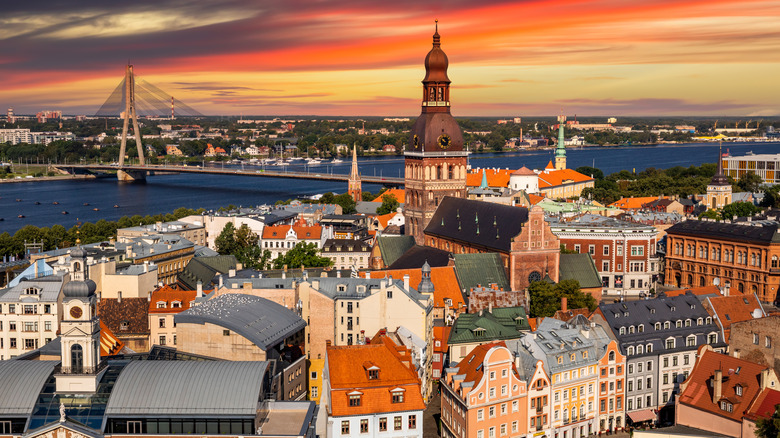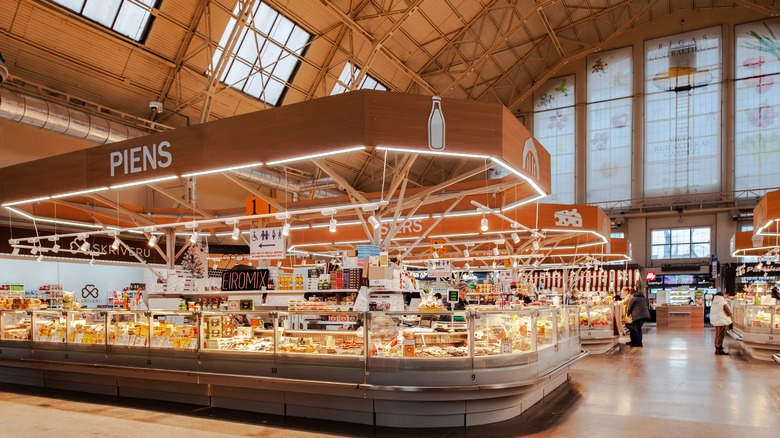One Of Europe's Most Walkable Destinations Is A Wildly Underrated City With Scenic Rivers And Cozy Cafes
Riga, the charming capital of Latvia, has been recognized as one of Europe's (and thereby the world's) most walkable cities by investment site Euro Insider Monkey, thanks to its safe environment, good air quality, and the convenience of strolling between its wonderful top five attractions, which are all within 1.5 miles from each other. But more so, Riga's languorous, flat streets are well-known for their quiet, scenic charm, making the stroll around its wonderful old town as serene as it is beautiful.
The old town is the highlight of a walk around Riga, with its charming streets, cozy cafes serving regional food and drink, and the tight-knit collection of sights. But stray a little, and you'll find the leafy Bastejkalna Park (Bastion Hill) with the scenic Pilsetas canal flanked by trees. Follow its banks in the direction of the train station to find the canal flowing into the impressive Daugava River. Cross the river to visit Āgenskalns, a quiet neighborhood with historic wooden architecture and the Āgenskalns market. Additionally, Riga is renowned for its rich Art Nouveau architecture, most of which you'll find around Alberta Street.
The closest international airport to Riga is Riga International Airport, which is about 6 miles away. To get to the city, you'll either need to take a taxi, which takes about 12 minutes, or jump on the local bus, which takes about 30 minutes. For onward journeys, Riga's central rail station is well connected with routes to Tallinn, Estonia's underrated capital city, Warsaw via Vilnius, and one of Europe's most breathtaking fall train trips between Riga and Sigulda.
Touring Riga's top sights on foot
Begin your walk at the majestic, 13th-century Riga Cathedral. Take a close look at its striking, blue Walker organ before climbing the tower via a tight spiral staircase (217 steps), culminating in brilliant views of Riga's old town. From here, walk around Vecrīga, the old town, to explore its enchanting, car-free, cobbled streets lined with historic buildings. This entire part of town is UNESCO-listed due to its varied historical architecture, including Riga's huge quantity of beguiling Art Nouveau architecture.
A short walk leads to the House of the Blackheads, a striking orange-fronted guild house with roots in the 14th century, that now houses a museum, showcasing items from the Brotherhood of Blackheads (the guild from which the house took its name). A few steps away is St. Peter's Church, worth a quick visit to ascend its impressive tower, which, thanks to numerous rebuilds, has an elevator –– ideal for enjoying the panoramic views over the rooftops bending around the river. Outside, there's a sculpture of the Town Musicians of Bremen, a representation of the four animals from the Brothers Grimm story who prevented a robbery by looking through a house's window. Here, they're looking through an Iron Curtain, a reference to Latvia's independence from the Soviet Union in 1991.
The last of the major sights in Riga's old town is Riga Central Market. The market is about 10 minutes away on foot and is found inside a cavernous converted Zeppelin hangar. The space is vast and hosts all kinds of produce, including local cheeses and fruits, as well as restaurants serving local specialties.
What and where to eat in Riga
As you might expect from a country often called Europe's hidden culinary gem, delicious dishes are omnipresent in Latvian cuisine, with dishes stuffed with local vegetables, meat, and smoked fish. The national dish is undoubtedly pelēkie zirņi ar speķ, a simple stew stuffed with gray peas (visually similar to chickpeas) and bacon, often served alongside freshly baked rye bread. But expect a healthy amount of wild mushrooms too, as Latvians are avid foragers, often pairing freshly foraged chanterelles with ham and lovely big dollops of cream.
For classic Latvian dishes, you can do no better than an afternoon looping the stalls at Riga Central Market, sampling rye bread, smoked fish, and sklandrausis, a traditional vegetable rye pastry pie filled with things like carrots and potatoes. For a more modern take, Martina Bekereja serves all types of pastries, perfect for lunch or breakfast, in the company of locals. Black Magic Bar is another good option, but expect a healthy menu of chocolates and a surprising aesthetic that leans towards the medieval, in homage to Riga's storied black balsam (a traditional herbal liqueur). Inside, you'll find doors disguised as bookshelves and other whimsical touches, like medicine cabinets displaying spirit bottles and tables lit by candlelight.
Riga's first Michelin star was awarded in 2023 and went to the wonderfully inventive Max Cekot Kitchen. Here, locally grown ingredients are magicked into beautiful-looking creations that are often finished tableside with vibrant fresh flowers, by head chef Max Cekot. For more refined dining, but with a traditional menu, try Milda, which serves rustic regional recipes like grey peas and potato dumplings with a subtle modern twist.


